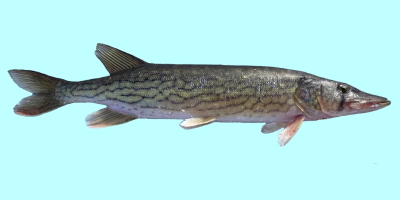|
|
Pike recipes for Baked Pike, Simmered Pike, Fried Pike, Broiled Pike, Poached Pike, Smoked Pike
The pike is known for its lean, low fat, firm flesh, which is yellow when raw but flaky white when cooked. Pike inhibits fresh waters of rivers but its flesh is as nutritious as that of saltwater fishes. Pike keeps very well and can be cut into fillets and prepared like any lean fish.
|
|
Pike recipes:
|
Pike (Esox lucius)
|
|
|

Also known as:
Great Northern Pike, Common Pike,
Amur Pike, Jack, Jackfish,
Chain Pickerel,
Grass Pickerel.
Description:
The largest, and most voracious, predator of northern waters. The most widely distributed freshwater fish in the world, found in northern Asia, Europe, and North America. Found in nearly all Minnesota lakes and streams except for the lower reaches of the North Shore creeks and the well-drained watersheds of the southeast.
A river fish which can weigh up to 9lb, known for having many very sharp teeth. It is said to have a muddy flavour and is not easily available.
A long and toothy fish that has a head shaped like a large duck bill and is often mistaken for a muskellunge.
Best Cooking:
Pike is excellent for baking, grilling, broiling, deep frying, poaching, and steaming.
The secret to successful pike cookery is do not overcook. Whichever of the following cooking methods you choose, your pike will be cooked when its flesh becomes opaque yet is still moist all the way through.
Buying Tips:
Quality pike is easy to recognize. Fresh pike never smells fishy, and the eyes should appear bright and clear, almost alive. The gills should be clean, and the skin moist and with tightly adhering, shiny silver scales. Fresh pike flesh will give slightly when you press it with a finger, then spring back into shape.
When choosing pike steaks or fillets, whether they’re fresh or previously frozen, look for moist, translucent (never dried out) flesh. Keep pike cool on the trip from the market to your house. Never let it stay unrefrigerated for long.
How to clean Pike:
To scale, put pike in a bucket and pour boiling water over both sides. Then place it in the sink under cold running water. Grasp the fish firmly by the gills and scrape off scales with a fish scaler or small, dull knife. Using short strokes, work from the tail to the head.
To remove the head, cut the flesh on both sides with a knife. If the fish is small, slice directly through the spine. For a larger fish, place the knife between vertebrae and tap the back of the knife with a hammer. Cut off the tail with a sharp knife.
How to fillet Pike:
Make vertical cut behind head, down to, but not through the backbone. Turn knife flat and parallel to the backbone and cut backward along top of backbone. You should be able to feel and hear "clicking" rib-bones and "Y" bones being cut through with the blade. There is a row of small bones down the center, that could be removed with a V-shaped cut along each side of the center bones. With the backbone exposed, bones will be observed running parallel to it on either side. Make a cut down and slightly inward along the outer edge of these bones. Work down and over the ribs and remove the flank fillet. Repeat for other side. Cut fillet free from each side of dorsal fin back to tail.
How to Store:
To store pike, remove packaging, rinse fish under cold water, and pat dry with paper towels. Fish deteriorates when it sits in its own juices, so place it on a cake rack in a shallow pan filled with crushed ice. Cover with cling wrap or foil and set in the coldest part of the refrigerator. Pike will store well this way for up to two days.
Frozen pike will keep 2 months in a refrigerator freezer compartment and 3 to 4 months in a deep-freeze. Use lined freezer paper and wrap fish tightly from head to tail with at least two layers of paper. You can thaw the fish or cook fillets without defrosting. To thaw slowly, unwrap, place fish in pan, cover, and leave for 24 hours in the refrigerator. To thaw more quickly, place the whole fish (in a waterproof bag) in a sink with cool running water, allowing about 30 minutes per pound (450g). For fastest thawing, use the defrost cycle of your microwave, allowing 2 to 5 minutes per pound, with equal standing time in between zaps.
Nutrition Value:
The pike is low in saturated fat, no sugar, very high in manganese, phosphorus, selenium, and in vitamin B12, high in calcium, niacin, potassium, and in thiamin.
Pike (cooked, dry heat), 1/2 fillet (5.5 oz / 155g)
Calories: 175
Protein: 38g
Carbohydrate: 0.0g
Total Fat: 1.4g
Fiber: 0.0g
Excellent source of Niacin (4.3mg), good source of: Calcium (113mg), Magnesium (62mg), and Potassium (513mg)
When cooked (dry heat), Northern pike provide 0.164 grams of omega-3 fatty acids, derived from Eicosapentaenoic Acid 0.042g, Docosahexaenoic Acid 0.095g, and Alpha Lipoic Acid 0.027g, per 100 grams of Northern pike.
Substitutes for Pike:
Freshwater fish, Trout or Whitefish.
|
Fish Recepies
Back to top
|
|
|

